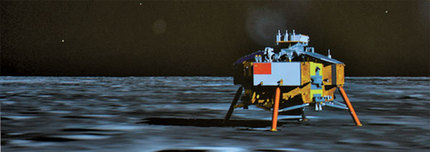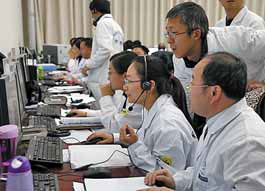Touch Down
Updated: 2013-12-15 08:11
By Zhao Lei (China Daily)
|
|||||||||||
Chang'e-3 lands on lunar surface, realizing China's long-cherished dream to reach the moon
A Chinese lunar probe soft landed on the moon at 9:11 pm on Saturday, making China the first nation to put a probe on the moon in nearly four decades. As an estimated hundreds of millions watched China Central Television's live broadcast, the 3,780-kilogram probe Chang'e-3 began at 9 pm to descend on a parabolic trajectory from 15 kilometers above the moon's surface.
Before touching down, the probe - which incorporated a robotic lander and a rover, the Yutu, or Jade Rabbit - went through six stages of deceleration, slowing from 1,700 meters per second.
The variable thrust engine Chinese scientists developed can generate up to 7,500 Newtons of thrust.
The craft hovered for about 20 seconds at about 100 meters above the lunar surface, using high-precision, fast-response sensors to survey the landing area to avoid possible obstacles and select an optimal location to set down.

At 3 meters above the surface, the engine shut down and the probe free-fell on the Sinus Iridum, or Bay of Rainbows - a lunar area that remains unstudied and should enable smooth communication and ample sunshine with its level terrain.
The whole process lasted about 12 minutes with all the sophisticated maneuvers being executed according to preset programs without human control. Controllers called the 12-minute period the mission's most strenuous and crucial moment.
Four minutes after the landing, Chang'e-3's solar panels unfolded, providing energy to the lander and rover.
"There is no air on the moon so we cannot use a parachute like on Earth," China National Space Administration spokesman Pei Zhaoyu told an earlier news conference.
"Meanwhile, the gravitational fields and landforms on the moon are different from those on Earth. In addition, the probe will have to handle possible impediments or unstable positions in the landing process."
Up to 80 percent of Chang'e-3's equipment was new to Chinese engineers before the mission, the lunar probe's chief designer Sun Zezhou said.
News about Chang'e-3's landing on the moon has ignited applause and celebrations online, with many Internet users saying they are proud of the nation's new space exploration achievement. Many netizens also said the mission has made the Chinese people's long-cherished dream of reaching the moon a reality.
On Sunday morning, the spacecraft would unleash the Yutu, a six-wheeled rover with advanced equipment and mechanical legs that can extract soil samples.
The Chang'e-3 probe was launched by a Long March-3B rocket at 1:30 am on Dec 2 at the Xichang Satellite Launch Center in Sichuan province. It entered a circular lunar orbit on the afternoon of Dec 6 after about 112 hours on an Earth-Moon transfer orbit. Two orbital corrections were made during its flight toward the moon, the Beijing Aerospace Control Center said.
Chang'e-3's successful landing adds to a list of 22 soft landings on the moon achieved by the United States and the former Soviet Union in the 1960s and '70s. Chang'e-3 has earned China a seat in one of the world's most prestigious clubs and gives new energy to the cause of moon expeditions that have been suspended for more than 37 years.
The last landing was on Aug 18, 1976. The former Soviet Union's Luna-24 made a soft landing, marking the last lunar adventure in the decade-long space race between the USSR and the US.
The first man-made object from Earth to ever reach the moon was the Soviet spacecraft Luna-2. It crashed, rather than landed, on the moon on Sept 14, 1959.
The Soviet Union realized the first lunar soft landing with the Luna-9 on Feb 3, 1966.
The Chang'e-3 mission is the second phase of China's lunar program, which includes orbiting, landing and returning to Earth. It follows the success of the Chang'e-1 and Chang'e-2 missions in 2007 and 2010.
zhaolei@chinadaily.com.cn
|
A photo of a screen at the Beijing Aerospace Control Center shows an artist's depiction of China's lunar probe Chang'e-3's successful landing on Saturday night. It is the first time the country has soft landed a spacecraft on an extraterrestrial body. China became the third country to land on the moon, after the United States and the former Soviet Union, and the first to do so in about four decades. Li Xin / Xinhua |
|
Scientists closely follow Chang'e-3's journey to the moon at the Beijing Aerospace Control Center. Wang Jianmin / Xinhua |
|
A photo taken of the screen at the Beijing Aerospace Control Center shows the moon's surface as transmitted by Chang'e-3. Wang Jianmin / Xinhua |
(China Daily 12/15/2013 page1)
Today's Top News
China's lunar probe soft-lands on moon
China slams Abe's ADIZ comments
Leaders vow to steer steady path
Execution may hit joint projects
Chang'e-3 moon landing on Sat. night
ASEAN cautious on air zone debate
Local govt debts get attention
South Africa admits error over "schizophrenic" signer
Hot Topics
Lunar probe , China growth forecasts, Emission rules get tougher, China seen through 'colored lens', International board,
Editor's Picks

|

|

|

|

|

|








